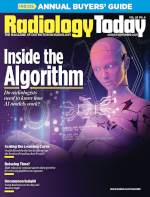 Editor’s Note: Educated Guess?
Editor’s Note: Educated Guess?
By David Yeager
Radiology Today
Vol. 24 No. 6 P. 4
AI is hot. It’s nearly impossible to read or watch the news without hearing about AI revolutionizing chat algorithms, military technology, and, well, almost everything that uses computer code. The drumbeat for AI has been going on for years in radiology, to the point where it’s almost background noise, but how much do radiologists need to know about AI algorithms? It’s been well documented that they are only as good as the data they’re trained on, and their performance can vary over time. It’s also difficult to determine exactly how they reach their conclusions. Are they evaluating data that are essential to clinical care or extraneous factors that produce a plausible result?
In our cover feature, Beth W. Orenstein takes a look under AI’s hood. More specifically, she asks several experts what radiologists really need to know about AI in order to feel confident in the algorithms’ conclusions. Although it isn’t necessary to be a computer scientist to evaluate AI’s accuracy, there are some steps radiologists can take to ensure that they’re getting the best advice from these ever-multiplying tools that range from workflow assistance to flagging important findings. One thing is certain: AI is not going away.
One of the reasons for AI’s allure is its ability to help radiologists manage the massive number of images that they’re routinely confronted with. As imaging volumes continue to grow faster than new radiologists can be trained, AI is increasingly being seen as a means to keep up. Orenstein examines the use of AI in chest imaging to triage emergency department patients with chest pain, predict heart disease risk, improve lung nodule detection, and streamline workflow.
AI’s cousin, radiomics, is also worth evaluating. Radiomics algorithms quantify pixel data on medical images. The quantified data are then evaluated by data characterization algorithms to detect features that cannot be seen with the human eye. Although no radiomics software is FDA approved at this time, and there are some technical challenges that need to be addressed, researchers believe it will have useful applications for screening, predicting disease prognosis, and evaluating treatment response. Rebecca Montz has an update on when and how radiomics may be useful in clinical contexts.
In non-AI news, Keith Loria reports on high-relaxivity MRI contrast agents, as well as some nongadolinium alternatives, and how they may affect clinical practice. For all of the details, turn to page 22.
Enjoy the issue.
— Dave Yeager
david.yeager@gvpub.com
